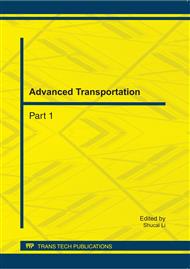[1]
Shao Shi-ming and Waug Yun: Methods of Reducing Resistance and Improving Seakeeping Qualities of High Speed Displacement Vessels. Ship Engineering. Vol. 4 (1982), pp.10-19
Google Scholar
[2]
KARAFIATHG. and FISHER S C: The effect of stern wedges on ship powering performance. Naval Engineers Journal. Vol. 3 (1987), pp.27-38.
DOI: 10.1111/j.1559-3584.1987.tb02113.x
Google Scholar
[3]
WU Fan; LU Xiao-ping; HUANG Xiao-ming: Vibration characteristic analysis of displacement square tail ship with or without flap. Journal of Naval University of Engineering. Vol. 5 (2005), pp.51-55
Google Scholar
[4]
Ji Heng-teng; Chen Jia-rong; Li Wei: Several Stern Modification Measures for Warships. Chinese Journal of Ship Research. Vol. 3 (2006), pp.41-46
Google Scholar
[5]
Wu You-li and Xiao Liang: FE Analysis of Vertical Adjustable Stern Flap in Wake Field. Chinese Journal of Ship Research. Vol. 3 (2007), pp.78-80
Google Scholar
[6]
Cave W L and Cusanelli D S: Effect of stern flaps on powering performance of the FFG-7 class. Marine Technology. Vol. 1 (1993), pp.39-50.
DOI: 10.5957/mt1.1993.30.1.39
Google Scholar
[7]
CHENG Ming-dao; LIU Xiao-dong; YU Jian-hua; XU Jun; ZHANG Jian-wu: Power performance investigation on a high-speed surface warships with a stern flap by sea trials. Journal of Ship Mechanics. Vol. 10 (2006), pp.1-7.
Google Scholar
[8]
CHENG Ming-dao; LIU Xiao-dong; WU Cheng-sheng; ZHANG Jian-wu: Energy saving mechanism of stern flap installing on the high speed displacement ship. Journal of Ship Mechanics. Vol. 9 (2005), pp.26-30.
Google Scholar
[9]
Shao Shi-ming and Wang Yun-cai: THE EFFECTS OF STERN TRIMMING FLAP ON RESISTANCE OF HIGH SPEED CRAFT. Shipbuilding of China. Vol. 1 (1981), pp.29-39.
Google Scholar
[10]
Stefano Brizzolara. Hydrodynamics analysis of interceptors with CFD methods[C]. FAST2003
Google Scholar
[11]
Gregory Fridman, Kirill Rozhdestvensky, Alexander Shlyakhtenko. Theory and practice of application of the interceptors on high-speed ships[C]. FAST2007
Google Scholar
[12]
Sverre Steen. Experimental Investigation of Interceptor Performance[C]. FAST2007
Google Scholar
[13]
Zuo Wen-qiang; Dong Wen-cai; Xia Xiang; Lu Wen-li: Experimental Study on the Effect to Resistance of WPC by Stern Interceptors. Chinese Journal of Ship Research. Vol. 4 (2006), pp.52-55.
Google Scholar


